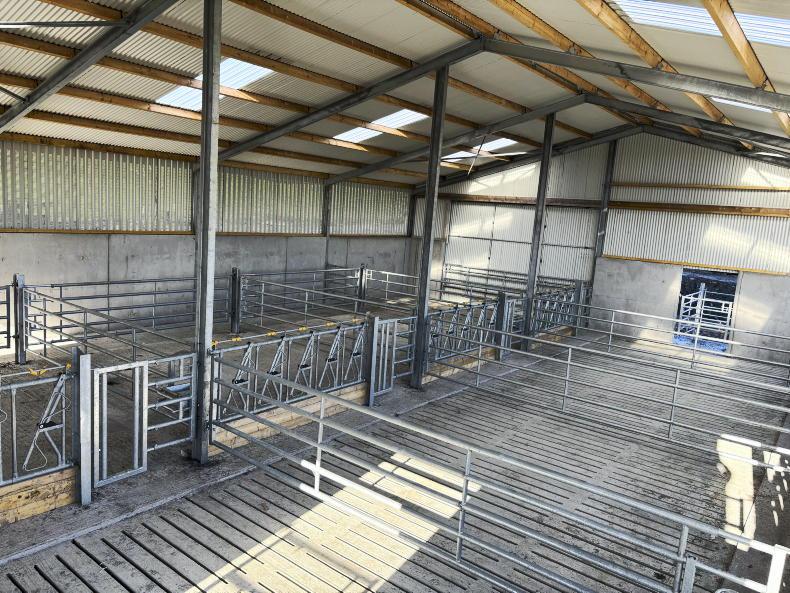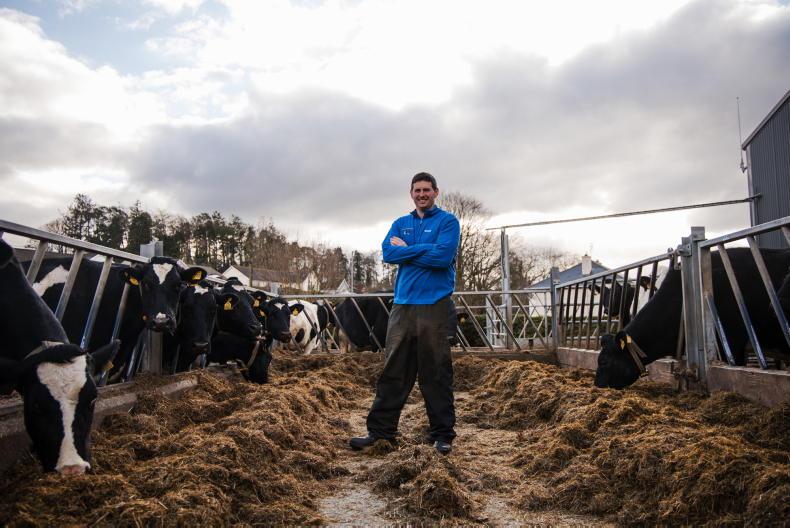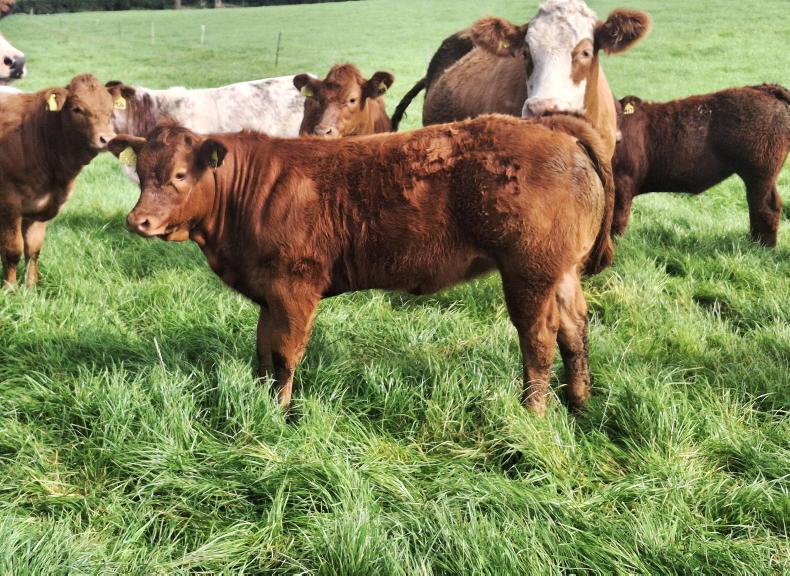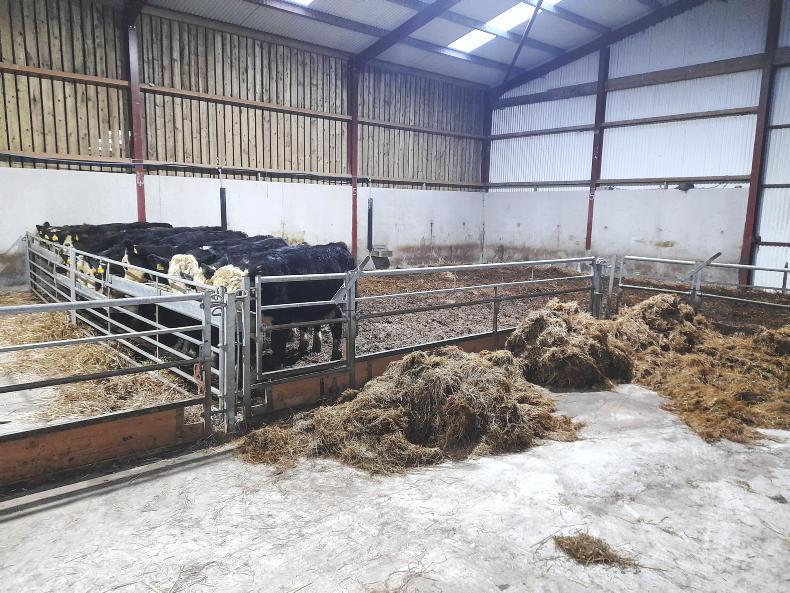Again, I’m running last minute trying to get cattle sheds washed and ready whilst the cattle are standing at the other side of the door waiting to get in.
Only for my father-in-law doing a couple of days washing and me pulling a couple of very late nights, I never would have gotten everything I needed to do, done in time. But in my defence, I really didn’t expect to need to house as many cattle as I have housed this early in the year, but unfortunately land has just become too wet.
I have some fields of nice grass, fields that I would have spread fertiliser on 2-3 weeks ago, but I’d say grass utilisation is less than half and as grass dry matter is extremely low also, I’d say the performance from the grass that stock are eating is relatively poor.
Feeding
I had started to feed my cows a lick of meal at grass, just to get them warmed up before housing. As I’ve never had to feed all my cows meal at grass in September before, I obviously don’t have enough troughs, so I was just feeding them on the grass, same system as a sheep snacker. A blob on the ground then walk forward a couple of meters and another blob on the ground.

Grass is better utilised by stores lambs now, writes Strain.
I used to use this system years ago to get a bit of calcium and magnesium into cows in the spring and it works very well on dry ground, but the key words in that statement are “dry ground”. Water logged ground is just not quite as successful.
As I have started to buy lambs again, there is no point in trying to graze grass with cattle if they are wasting the half of it, when the lambs will make good use of it later. So, at this stage more or less all heavy cattle are in the shed.
Most of the calves are still out and hopefully will be for some time to come, but I have to say, early and all as it is, there is a lot more pleasure feeding cattle in the shed on a dark wet morning than there is trying to keep your wellies from getting stuck in the clabber round a muddy trough in the field.
Lambs
As already said, I have started buying lambs again and I’m spending my time trying to ease them on to red clover swards. I’m putting each batch on to normal grass for a week after they arrive. Then on to red clover in the evening time with a full belly, in the hope that they won’t eat too much and then back to normal grass the next morning.
I do this for three consecutive days before I leave them on it full time as introducing red clover or any clover for that matter too quickly can induce bloat.
Then when the next batch arrives, I have to start all over again, I’d say my neighbours, never mind the lambs themselves, are wondering what the hell is going on. Thankfully, there’s a few lambs in every batch so far that were obviously being fed, so a bit of meal and rattle the bucket and they’re not too hard to move.
Again, I’m running last minute trying to get cattle sheds washed and ready whilst the cattle are standing at the other side of the door waiting to get in.
Only for my father-in-law doing a couple of days washing and me pulling a couple of very late nights, I never would have gotten everything I needed to do, done in time. But in my defence, I really didn’t expect to need to house as many cattle as I have housed this early in the year, but unfortunately land has just become too wet.
I have some fields of nice grass, fields that I would have spread fertiliser on 2-3 weeks ago, but I’d say grass utilisation is less than half and as grass dry matter is extremely low also, I’d say the performance from the grass that stock are eating is relatively poor.
Feeding
I had started to feed my cows a lick of meal at grass, just to get them warmed up before housing. As I’ve never had to feed all my cows meal at grass in September before, I obviously don’t have enough troughs, so I was just feeding them on the grass, same system as a sheep snacker. A blob on the ground then walk forward a couple of meters and another blob on the ground.

Grass is better utilised by stores lambs now, writes Strain.
I used to use this system years ago to get a bit of calcium and magnesium into cows in the spring and it works very well on dry ground, but the key words in that statement are “dry ground”. Water logged ground is just not quite as successful.
As I have started to buy lambs again, there is no point in trying to graze grass with cattle if they are wasting the half of it, when the lambs will make good use of it later. So, at this stage more or less all heavy cattle are in the shed.
Most of the calves are still out and hopefully will be for some time to come, but I have to say, early and all as it is, there is a lot more pleasure feeding cattle in the shed on a dark wet morning than there is trying to keep your wellies from getting stuck in the clabber round a muddy trough in the field.
Lambs
As already said, I have started buying lambs again and I’m spending my time trying to ease them on to red clover swards. I’m putting each batch on to normal grass for a week after they arrive. Then on to red clover in the evening time with a full belly, in the hope that they won’t eat too much and then back to normal grass the next morning.
I do this for three consecutive days before I leave them on it full time as introducing red clover or any clover for that matter too quickly can induce bloat.
Then when the next batch arrives, I have to start all over again, I’d say my neighbours, never mind the lambs themselves, are wondering what the hell is going on. Thankfully, there’s a few lambs in every batch so far that were obviously being fed, so a bit of meal and rattle the bucket and they’re not too hard to move.











SHARING OPTIONS